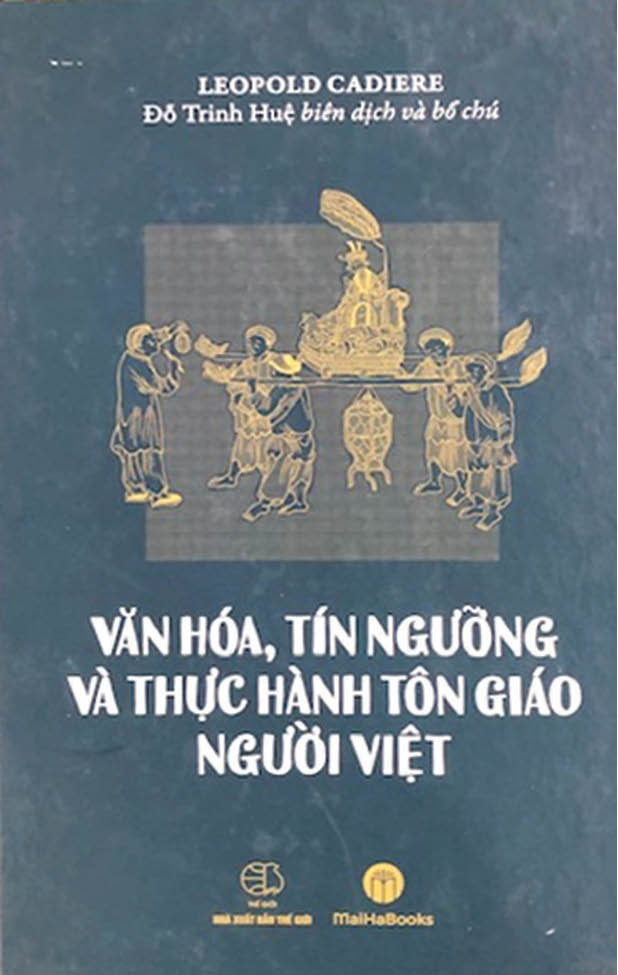
The cover of the book “Memoirs of an Old Man Who Studied Vietnam”
L. Cadiere is a very familiar name to not only Hue but also the circle of researchers on Vietnam in many countries because he was the chief editor of the 30-year-old Bulletin des Amis du Vieux Hué (B.A.V.H.,) a quarterly magazine and a source of authentic documents about Hue and Central Vietnam for researchers.
However those who use L. Cadiere’s spiritual legacy have not yet fully understood his life and career. For that reason, Do Trinh Hue, former Head of the French Department of Hue University of Education, has spent over 10 years and a lot of effort translating and compiling a large series of books on L. Cadiere.
It can be said so because the first book "Culture, Beliefs and Religious Practice of Vietnamese People (first printed in 2010 and reprinted in 2015 by Thuan Hoa Publishing House and reprinted this year with additions and correction by The Gioi Publishing House) is of 3 volumes (up to 900 large-sized pages).
The second book “Memoirs of an Old Man Who Studied Vietnam” with more than 300 large-sized pages has just come out this spring. Reading this series of books, we understand not only L. Cadiere’s entire life and career, but also the Vietnamese history and culture more deeply.
This article is particularly about the book Memoirs of an Old Man Who Studied Vietnam. Those who think about memoirs as ironic stories and exciting love affairs will certainly not find this book interesting. The book is for those who need documents and are interested in experience of living and studying especially on the new land.

The cover of the book “Culture, Beliefs and Religious Practice of Vietnamese people”
The book consists of 4 parts: 1- Life and Career of L. Cadiere; 2- L. Cadiere’s Publications, 3- L. Cadiere's Approach to Vietnamese Culture, Language, Beliefs and Family; 4- Memoirs of an Old Man who Studied Vietnam.
The first two sections of the book thus help readers fully grasp the most essential facts in L. Cadiere’s life and career, a "life of 86 years 63 years of which were for Vietnam.” In June 1953, when he was brought back to Hue from Vinh, although there were proposals for L. Cadiere to return to France, he refused. “I have dedicated my whole life to this land. I want to stay and die here.” L. Cadiere’s wish did finally come true.
More than 250 L. Cadiere’s publications listed and classified by Do Trinh Hue in 9 categories show that his legacy is huge and diverse including ethnology, customs and habits, philosophy, beliefs, religion, culture and civilization, archeology, art, geography, anthropography, history, memoirs, language, literature, education, botany, biology, environment, tourism and some famous writers...
To help readers easily access and understand correctly values as well as principles and methods that L. Cadiere employed to make those works, Do Trinh Hue dedicates the third part of the book to an elaborate essay of 60 pages about L. Cadiere's approach to Vietnamese culture, language, beliefs and family.
Through that essay, readers and researchers in any field will be able to learn useful lessons. Do Trinh Hue emphasizes working based on reality of life and visual things and events such as a stone, a tree, etc. Those lessons are not new, but still very useful.
His 250 works cost L. Cadiere’s entire life. “… by studying and understanding Vietnamese people, I really love them. I love them for their intelligence and acuteness in their thinking and their spiritual virtues,” confided L. Cadiere on the occasion that marked his 50 years in Vietnam:
In his book reprinted the third time when talking about beliefs and the religious practice of Vietnamese people, he advised not to weaken the family in Vietnam, but strengthen it by all means.
In the memoir section, which accounts for 2/3 of the book, L. Cadiere mainly recorded his process of studying the Vietnamese language from the moment he had got on the ship to Vietnam. He did not aim to write about his life in detail, but wrote at the request of the Governor-General of French Indochine at the time as a man who studied Vietnam.
Do Trinh Hue must have worked very hard in order to access more than 30 issues of Indochine Journal from 1942 to 1945 at archives in other countries, which contain L. Cadiere’s memoirs.
Although focusing on academic practice and research of the Vietnamese language, L. Cadiere took us from Danang to Hue, Quang Tri, Dong Hoi, Phong Nha, etc., at the time when Danang as well as Dong Hoi were only sand, and the national road from Danang to Hue had not appeared yet with the notion that language should not be learnt through books only.
Also through the book, we know that L. Cadiere used to teach Vietnamese to Dr. Yersin,” a Westerner who also loved Vietnam so much that he wanted to die in Vietnam. The book is therefore very useful for foreign language learners. It at the same time provides vivid materials about the social and natural life more than a century ago - mainly in Binh Tri Thien.
Story and photos: NGUYEN KHAC PHE